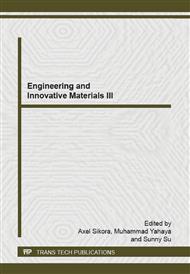p.65
p.71
p.76
p.81
p.85
p.91
p.96
p.101
p.105
Recycling of Pre-Fabricated Carbon-Fiber Waste as Filler for Sandwich Glass-Fiber Auto Parts
Abstract:
This study explored the possibility of recycling pre-fabricated carbon to use as filler in conjunction with talc to produce glass-fiber reinforced unsaturated polyester composites. Specimens with six different resin compositions were prepared using hand lay-up technique. The structure and property relationship was characterized through tensile test and microstructure analysis. Mechanical properties incorporated with the failure analysis suggest that the recycling of carbon is feasible. The application of the recycled carbon showed the improvement on the less variation on the mechanical properties. The percent elongation at break tended to reduce, and traded-off with the deterioration on tensile strength at break and elastic modulus. Mixing with 10-15 wt% recycled carbon and 5-10 wt% talc powder was suggested to yield the optimal tensile properties. Moreover, the recycled carbon previously coated with unsaturated polyester guides the uniform distribution when required to process with a high-polarity material by reducing the polarity effect.
Info:
Periodical:
Pages:
85-90
Citation:
Online since:
October 2014
Price:
Сopyright:
© 2014 Trans Tech Publications Ltd. All Rights Reserved
Share:
Citation:


